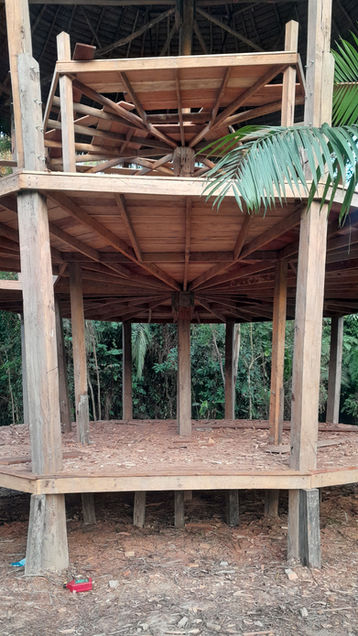The Museum Project

Context
Climate change is seriously endangering the Amazon by causing historic drought, due to deforestation linked to ranching and agricultural expansion. Researchers warn of the risk of functional destruction of the Amazon, pointing out that the titling of indigenous territories could significantly reduce deforestation. Protecting and restoring forests, particularly in the Amazon, is crucial to achieving greenhouse gas emission reduction targets by 2030.

Puerto Miguel
Puerto Miguel has a population of around 400, mainly descendants of the indigenous Kukama-Kukamiria/Cocama people. The Kukama language is in decline, with only 2.5% of the 19,000 Kukamas speaking it in 2003. Despite a history marked by the arrival of settlers, rubber fever and development pressures, the Kukamas have preserved their cultural heritage and traditional way of life thanks to their resilience. Despite the land reform of 1969 symbolizing emancipation, the Kukamas find it difficult to openly assert their identity due to the historical stigma of subordination, underlining the challenges of recognizing indigenous identities in the wider society.

Tourism
Puerto Miguel, once focused on agriculture and fishing, is undergoing a major economic shift with the emergence of international tourism, resulting from its location in the heart of the Amazon rainforest. This transition marks the decline of the peasant identity in favor of a tourism-driven dynamic. With around 20 places per lodge, welcoming mainly Dutch, American, German, Spanish and French tourists for an average of 3 days, the rainy season attracts even greater crowds.
Project stakeholders

Mariposa, an association of artisans mainly composed of women, promotes craftsmanship in chambira, a local palm tree, with certification and active collaboration with the Ministry of Tourism.

Nelvis Parades Pacaya, a painter, plays a crucial role in volunteering to teach Shipibo and Kukama indigenous culture to preserve this ancestral knowledge and arouse the interest of young people throughout the Amazon.

Radio Ucamara supports the defense of the territory and the river, promotes Kukama culture, and participates in research, education, awareness and defense of human rights projects.

AKUU actively supports the Museum Project based on an in-depth impact assessment, to preserve culture, stimulate the local economy, raise conservation awareness and strengthen community engagement.
A MUSEUM IN 3 DISTINCT PARTS
A museum is a space for sharing knowledge, promoting discovery, information, and encouraging reflection, while broadening visitors' horizons with new ideas. To achieve this objective, the museum was designed in three distinct sections.
First part, the cultural interpretation center
Sala Kuruara, immersion in the Kukama aquatic universe
The first of these atmospheres will therefore transport tourists into the world of water andIgapo, a term used to describe flood-prone forest during flood season. Of thewooden structures will evoke the submerged forest and the depths of the rivers, while numerous sculptures representingaquatic fauna and flora will be suspended in space.


Sala Iwɨrati Tuwa, immersion in the Dense Forest
In this second room on a higher floor, visitors will be invited to immerse themselves in a second atmosphere evoking thedry land and dense forest. They will follow theIwirati Tuwa in this room and will thus have the opportunity to slip into the shoes of a jaguar, a large tapir and many other inhabitants of the forest.
Sala Tsumi, between sky and earth, shamanic Canopian immersion
Thus, for the third and final part of this cultural interpretation center, visitors will gain height and will be invited to go up to the highest room of the museum. They will learn a lot aboutspirits inhabiting the canopy, on the travels of the Tsumis, on shamanic culture etc…

Second part, the exhibition rooms
Third part, the store
Las Mariposas
Managed by "Las Mariposas", the final stage of the museum will be a boutique promoting local crafts, offering unique works of art and books about the Amazon, strengthening links with the local artistic community.

Architectural Design and Construction of the Museum
Inspired by images of the Tree House Lodge in Puerto Miguel, South American architect Maria Agustina Pistolesi worked on the plans for the museum.




TEAMS ON SITE
AKUU Team
In January, the team of volunteers led by Ines Gronsfeld, Léa Loiret and Raphaël Moreau, supervised by Yoann Rey-Ricord, will begin construction of the museum. A second team led by Dylan Cluzel will follow in May 2024. Building on its past success in the Amazon, Yoann Rey-Ricord ensures the success of the project.


Construction team
The construction team, led byAbraham Macuyama, an experienced leader who knows the village well, will include 11 skilled workers. The site manager will supervise the quality of the work and compliance with deadlines. AKUU's role will be to meet the needs of the site manager, ensuring fair remuneration for workers and promoting harmonious collaboration.
Governance
The association Mariposa will manage the store, donating a portion of the proceeds for upkeep, including those from the Amazon bookstore, initially established by AKUU and now managed by residentslocal. AKUU aspires to a minor role in decisions, recognizing that local residents are best suited to run the museum.


Visiting times and prices
The museum offers30 minutes visit per room, followed by an hour of exploration. The cost of entry covers fees and pays staff.Thirty percent profits will enrich the collections, and70% remaining will be shared between the Mariposa association, artists, employees and the community. Provisional prices vary from40 soles (10€) for foreign tourists tofree for local residents, inspired by a Colombian model.
The project in pictures
The forecast budget
The precise budgetary estimate for the construction of the museum, established by AKUU with the participation of the village of Puerto Miguel, amounts to€38,546.31 over 10 years. For the first 3 years, AKUU needs€13,982.51. The monthly maintenance cost of the museum is €400 over 10 years, with a cost of replacing the structure every 10 years. Costs in soles were converted to euros at an exchange rate of 1 euro = /S 4.06.















